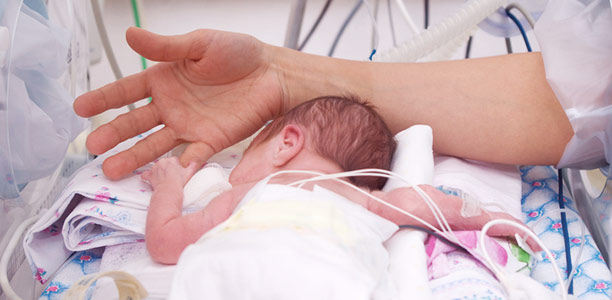Kylie, a Sydney-sider, is now the mother of three beautiful surviving babies. Her story is one of devastating heartbreak, but also of resilience and camaraderie.

Kylie co-founded, and is now the CEO of Miracle Babies Foundation.
“I think that being able to turn that experience into being able to support others and let them find their new normal, to help them find ways of coping and moving forward, has been special.”
The beginning of a long journey
“I got married quite young. At that time, I just thought that when you’re ready to have a family it all just happens. But for us, and I know for many others, it just wasn’t that easy. It was definitely a longer road than we ever would have expected. The first time I fell pregnant, I miscarried at 10 weeks. It was my first miscarriage, and I was absolutely devastated at the time. But you know, you pick yourself back up; we were thinking that we’ve fallen pregnant once, we’ll fall pregnant again.”
Kylie was later diagnosed with polycystic ovarian syndrome (a disorder involving infrequent and irregular periods that can lead to high infertility rates) after struggling for some time to fall pregnant again.
Taking the IVF path
Kylie and her partner decided to give in vitro fertilisation (IVF) a go – when mature eggs are collected and fertilised by sperm in a laboratory.
“Eventually, I fell pregnant with twins. We were just so excited and amazed, and everything was going fantastically.”
The loss of David and Angel
“One day, I went for a road trip to my sister – at the time, she was living a few hours away. Everything was going well; our doctor was happy. But on that trip, I had severe back pain and stopped to go to the toilet. As I got out of the car, my membranes ruptured – it was very scary.”
Kylie rushed into the nearest hospital, and the staff there didn’t really have much of an idea what was happening. Later that night, Kylie went into labour.
“I was only 16 weeks pregnant and I started having contractions. At the time, it was hard to really think about what was happening; you just think that it must be something else. But unfortunately, I was definitely having contractions. I went into hospital … and there was nothing that they could do.”
“The next 8-10 hours were just absolutely heart-breaking for us. We didn’t know if both babies were going to come, or if only one baby was going to come and the other would stay intact. We had no idea what to expect … it was a really, really tough time for us. In the end, both babies were delivered – a boy and a girl – and at 16 weeks they were unable to survive.”
One thing that really struck Kylie was just how formed her babies were at 16 weeks – to the point where she thought they could see family links in their features.
“They were our babies, and we named them David and Angel. It was just devastating. I don’t think there are many words that can describe how you can feel so low and empty – just shattered and broken, and feeling very, very empty. I think it hit again after going back home when, two days later, my milk came in, it just felt like another kick in the guts – a reminder that you don’t have your babies with you and there’s nothing you can do to change that. So, that was really hard going through those emotions.”
The story of Madeline
Kylie and her partner went through IVF again and managed to fall pregnant once more. Kylie was being monitored closely, with two-weekly ultrasounds and regular check-ups. At 22 weeks, the doctors discovered that Kylie’s cervix was almost open. This meant that Kylie required emergency surgery (to try and close the cervix) and had to stay in hospital.
“I remember my obstetrician coming in to explain to me the risks of having the surgery, but I guess the words that really stuck with me many years on were: ‘You are going to be in labour in a few hours and your baby is not going to be able to survive at 22 weeks. Surgery is the only real chance’. So, off to surgery we went, and I stayed in hospital for a week after that.”
 Kylie was eventually allowed home. Two days later, she went back for a follow up visit, and was diagnosed with cervical incompetence – a condition that occurs when weak cervical tissue causes preterm birth or the loss of an otherwise healthy pregnancy. This meant that Kylie had to remain in the hospital. The next 8 weeks were spent ‘trying to keep Madeline in’.
Kylie was eventually allowed home. Two days later, she went back for a follow up visit, and was diagnosed with cervical incompetence – a condition that occurs when weak cervical tissue causes preterm birth or the loss of an otherwise healthy pregnancy. This meant that Kylie had to remain in the hospital. The next 8 weeks were spent ‘trying to keep Madeline in’.
“We were allowed home at about 29 weeks. I lasted 2 days at home before my membranes ruptured; so, we went back in and I delivered Madeline. The stitch that was put in during the initial surgery had broken so I was able to have a vaginal delivery; that was one good thing as I was able to be awake for her birth and see her straight away.”
“She was born at just over 30 weeks and weighed 1,585 grams at birth. She was delivered really quickly, we had a quick little cuddle and then she was taken off to neonatal intensive care unit (NICU).”
Madeline required CPAP (continuous positive airway pressure; this applies continuous pressure to keep the lungs and airways open) for a couple of hours.
“She had her ups and downs, of course, with her patches of slow heart rates and rhythm changes, as well as times when she stopped breathing. As a parent, this was all quite scary. But she was finally allowed home after 6 weeks, weighing 2.2 kg.”
Unexpected, lifelong friendships
“I think the thing that sticks with me the most from that experience was that some of the people we met in NICU during that time are still lifelong friends today. We formed really solid friendships; I think that was such an important part of getting through that experience and being able to share what you are going through with others. We would talk about weigh-ins and then get excited together when our babies had put on weight. It was just a wonderful little community that brought so much comfort, particularly considering I was in there for the whole day and most of the night. This was definitely something that we weren’t expecting, but it really helped us through that experience.”
‘One should be two’ – the story of Marcus and Scarlet
Kylie and her partner had another round of IVF, and eventually fell pregnant with twins again.
“It was scary; but, we were thinking we’d be fine this time around – we know what’s going on and we’ve had the surgery. I was still having the same 2-weekly monitoring with ultrasounds and everything was going fine. The babies were growing well and I was actually enjoying some parts of this pregnancy for a change.”
At 22 weeks, Kylie’s cervix was showing signs of weakness again. She wasn’t able to have more surgery as a stitch was already in place.
“This time I only lasted up until 25 weeks before my membranes ruptured. They tried to stop my contractions for about two days, but on the second night, the contractions were just so strong. My obstetrician said that we had to deliver right then and there as they could no longer stop the contractions. Also, as I had the stitch in my cervix, I was at risk of rupturing my cervix – something that is very, very serious. So, we went in for an emergency C-section under full anaesthesia at 25 weeks.”
“The next thing I remember was being in recovery and asking a few times – while drifting in and out of consciousness – how my babies were going. I was told that I had had a boy and a girl; that was all I knew.”
“Many hours later I was taken up to NICU, whilst in the hospital bed, where I got to meet my babies. We named our little boy Marcus; he weighed 785 grams at birth. And we had Scarlet, who weighed 648 grams at birth. Both of them had to be resuscitated at birth; however, afterwards Scarlet was only on CPAP, which was very surprising for a twin 25-weeker. Marcus, unfortunately, required ventilation as his lungs just weren’t doing as well.”
“The next day, I was taken from the ward to NICU in order to spend as much time as possible with my babies. I think I was just in shock, as I don’t have a lot of memory of what happened over the next few days.”
“During the second night, I was woken up at 2am to be told that one of my babies was not doing very well, and that I needed to go up to the nursery. I was taken up in a wheelchair and was confronted by the neonatologist caring for Marcus. He had required a couple of blood transfusions during the night, and he had been moved onto ‘high frequency oscillation ventilation’.”
 “They did some scans, and his lungs had collapsed. He was also having fits – lots of things were happening for Marcus. He ended up passing away at lunchtime the next day, and I don’t know what words you can use to describe that emotion – when you feel like you are absolutely struck with grief. Your world just stops and you just can’t breathe. You can’t do anything and you just feel broken.”
“They did some scans, and his lungs had collapsed. He was also having fits – lots of things were happening for Marcus. He ended up passing away at lunchtime the next day, and I don’t know what words you can use to describe that emotion – when you feel like you are absolutely struck with grief. Your world just stops and you just can’t breathe. You can’t do anything and you just feel broken.”
“The only time I got to hold Marcus was for his baptism and to say goodbye. I never really got to hold him as his mum; to welcome him to this world with only love and joy, it was more with grief and heartbreak. That’s always been really hard to come to terms with. Going back and forth from the hospital for Scarlet was really tough for a while as well – one should be two, where is he?”
Scarlet’s battles
Scarlet faced a few life-threatening setbacks during her time in hospital. At one stage, she developed necrotising enterocolitis – a serious intestinal condition where the gut tissue is damaged and dies, potentially leading to a severe infection. Luckily, she didn’t require surgery.
Scarlet did end up, however, going in for laser eye surgery.
“The surgery was meant to be quite routine, as she was breathing on her own by that stage. However, when she came back from surgery, she wouldn’t wake up – so, she had to be ventilated. She remained like that for several days and the hospital couldn’t work out why.”
After many days of facing the unknown, doctors eventually were able to determine that Scarlet had anti-cholinergic syndrome, a condition where she wasn’t able to get rid of some of the drugs, such as the anaesthesia, from her body fast enough which subsequently had an effect on her nervous system.
“As a result, the doctors chose to stop her eye drops that she had been put on after the laser eye surgery. Amazingly, a few hours after not being given the eye drops anymore, she turned a corner and over the next six or so hours, she started to get back to being herself. This whole experience felt like such a huge step back – she didn’t require ventilation at birth but here she was requiring ventilation at 36-37 weeks.”
“Finally, we were able to take her home. It was absolutely joyous, but also bittersweet, as we were still grieving for Marcus. I think those next 12 months were probably the toughest and the loneliest – the most isolated – that I think I have ever felt. It’s definitely something that, unless you have experienced that sort of ‘brokenness’ before, is really hard to try and explain.”
Liam the 38-weeker: a different experience
Later, Kylie went on to have surgery on her cervix, which was basically to strengthen it. Kylie and her partner fell pregnant, and what was to follow would be “just a beautiful, amazing and completely different experience”: a 38-week pregnancy and a healthy, baby boy.
“The thing I always felt grateful for was that our obstetrician never said ‘no, stop, no more, you’ve been through enough’. He was always willing to work with us to help us have our family. So, we are very, very thankful to him. We couldn’t have done it without him.”
How are your children doing now?
 “They are doing really well now, definitely getting older. Madeline is 16, Scarlet’s 14 and Liam’s 10. The early years for Scarlet, and to a lesser extent Madeline, were definitely filled with things like a lot of speech therapy, occupational therapy, physio – all of those things. Scarlet barely spoke until she was about 3 and a half years old (after 2 years of speech therapy), and she’s still an extremely shy child. She has an amazing personality, but very shy. They’re all in mainstream schools; Scarlet has a bit of extra support through school, such as needing to have things explained in different ways, but they are all doing really well.”
“They are doing really well now, definitely getting older. Madeline is 16, Scarlet’s 14 and Liam’s 10. The early years for Scarlet, and to a lesser extent Madeline, were definitely filled with things like a lot of speech therapy, occupational therapy, physio – all of those things. Scarlet barely spoke until she was about 3 and a half years old (after 2 years of speech therapy), and she’s still an extremely shy child. She has an amazing personality, but very shy. They’re all in mainstream schools; Scarlet has a bit of extra support through school, such as needing to have things explained in different ways, but they are all doing really well.”
How did you come about being a co-founder of the Miracle Babies Foundation?
“Scarlet was about 12 months old; I received a call from one of the mums that I had met in NICU. She asked me to come along to a meeting of parents that were getting together to talk about their experiences and what they could do for the hospital. So, I went along to that and met a lot of amazing women who all had their own incredible experiences and journeys. We wanted to be able to fundraise and give back to the hospital, stay connected and support each other. Over the following months we formed the Miracle Babies Foundation. We were only very local in Sydney’s south west at the time, and we would turn up for monthly meetings at the hospital.”
 “Being a part of that organisation, particularly from the start, was just incredible. I hadn’t talked or shared a lot about my experiences and it took me many months to be able to do that. And I think the more I opened up, the more help I received – it really helped me process everything. Even many years on now, those feelings have never changed. You are always a bereaved parent, and you will always have had those babies in your lives who touched you. To be able to find out where I was able to be okay with my journey, took me many, many years. I remember in that first year after we lost Marcus sitting in my wardrobe telling my husband that I didn’t want to live anymore. So, there have definitely been times when I have been really, really low. However, I think that being able to turn that experience into being able to support others and let them find their new normal to help them find ways of coping and moving forward, has been special. Miracle Babies Foundation’s parent support program has grown from strength to strength and expanded nationally. I am very passionate about supporting families with their journey.“
“Being a part of that organisation, particularly from the start, was just incredible. I hadn’t talked or shared a lot about my experiences and it took me many months to be able to do that. And I think the more I opened up, the more help I received – it really helped me process everything. Even many years on now, those feelings have never changed. You are always a bereaved parent, and you will always have had those babies in your lives who touched you. To be able to find out where I was able to be okay with my journey, took me many, many years. I remember in that first year after we lost Marcus sitting in my wardrobe telling my husband that I didn’t want to live anymore. So, there have definitely been times when I have been really, really low. However, I think that being able to turn that experience into being able to support others and let them find their new normal to help them find ways of coping and moving forward, has been special. Miracle Babies Foundation’s parent support program has grown from strength to strength and expanded nationally. I am very passionate about supporting families with their journey.“
References
- Polycystic ovary syndrome [online]. Mayo Clinic; 2018 [cited 11 July 2018]. Available from: URL link
- In vitro fertilization (IVF) [online]. Mayo Clinic; 2018 [cited 11 July 2018]. Available from: URL link
- Incompetent cervix [online]. Mayo Clinic; 2018 [cited 11 July 2018]. Available from: URL link
- Continuous positive airway pressure (CPAP) [online]. Mayo Clinic; 2018 [cited 11 July 2018]. Available from: URL link
- Necrotizing enterocolitis [online]. Stanford Children’s Health; 2018 [cited 11 July 2018]. Available from: URL link
- Clinical practice guidelines: Anticholinergic syndrome [online]. The Royal Children’s Hospital Melbourne; 2017 [cited 11 July 2018]. Available from: URL link
 |
We asked parents what tips they have for parents, family and friends of sick or newborn premature babies who require extra care and support. Read those tips here. |
 |
Also read about Katelyn’s experiences of having Piper, her daughter, born at 29 weeks, and the journey of Piper as a sick premature baby separated from her mother at birth here. |
 |
Discover support services and resources in Australia for parents, family members and caregivers of sick or premature babies. Find out more about available in-hospital and external services here. |




 (7 votes, average: 3.57 out of 5)
(7 votes, average: 3.57 out of 5) 






